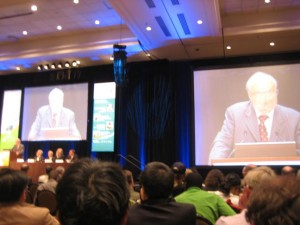Rasmus & Gavin
The reason why scientists like going to conferences (despite them often being held in stuffy hotel basements) is because of the conversations. People can be found who know what they are talking about, and discussions can be focused clearly on what is important, rather than what is trivial. The atmosphere at these conferences is a mix of excitement and expectations as well as pleasure at seeing old friends and colleagues.
The two of us just got back from the excellent ‘Open Science Conference‘ organised by the World Climate Research Programme (WCRP) in Denver Colorado. More than 1900 scientists participated from 86 different countries, and the speakers included the biggest names in climate research and many past and present IPCC authors.


 Last week, there was a
Last week, there was a 